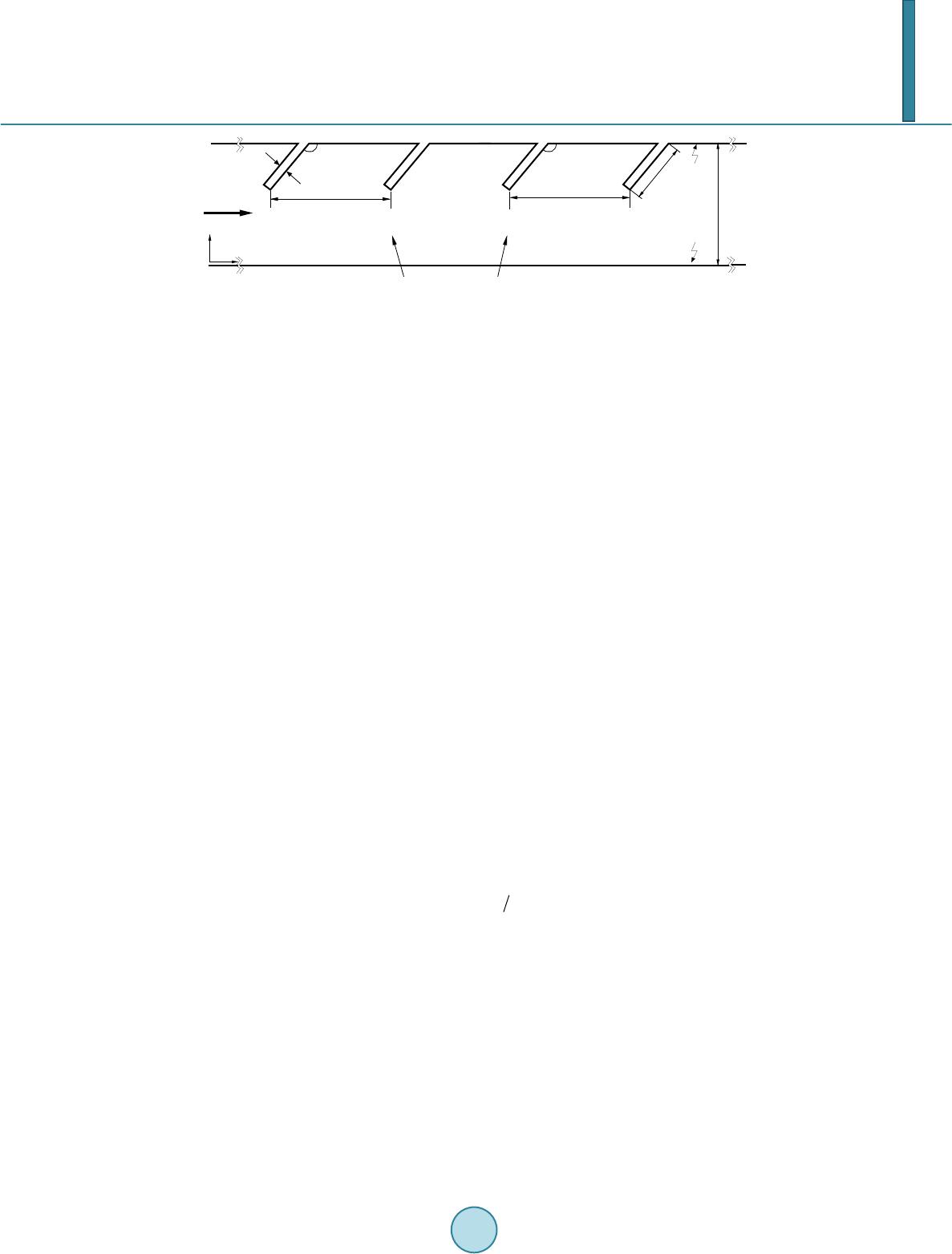
Y. X. Zhan, T. S. Park
Figure 1. Flow configuration.
3. Results and Discussion
Figure 2 shows time mean streamlines and temperature contours for α = 50˚, 70˚, 90˚, 130˚, respectively, at
. Recirculation regions are identified between the baffles for all tilt angle. Center of the recirculation is
moved to the downstream due to the effect of the oblique plate tilt angle. Instantaneous streamlines and temper-
ature contours during one time period of flow are presented in Figure 3 at
, α = 50˚, 90˚. It can be
seen that vortices induced by oblique plate along the walls remove to the downstream. The main stream moves
toward the upper and lower walls in an alternating manner. At the same time, the counter-rotating vortices are
also generated along the lower wall by the oblique plate. Compared with the α = 50˚ and α = 90˚, larger size of
vortices are formed and the number of the vortices is increased for the case of α = 90˚. As the result, more active
mixing and scalar transport are induced.
The wall heat transfer depends on the geometrical condition. Figure 4 shows the Nusselt number for different
tilt angles, as
increase. The local Nusselt number is defined as follows:
. The
mean Nusselt number along the channel wall is expressed by integrating the local Nu on the channel wall:
As can be seen that,
is increased as increasing
. In steady state, the variation of
is not sensitive to the tilt angle. But as
increases, the local
is strongly depends on the tilt angle.
For small
, the recirculating flow reduces the local
because it makes the thermal boundary layer thicker
(see Figure 2). For larger Re, size and number of the vortex plays major role for heat transfer enhancement (see
Figure 3). We can see that
is maximized at
.
This paper is to present the effect of the tilt angle on flow structure and heat transfer. Figure 5 shows distri-
bution of time-averaged local
, time-averaged local skin friction coefficient
and time-averaged pres-
sure coefficient
along upper wall at
. The value of
reflects the appearance of flow separa-
tion and reattachment. The peak is related to the accelerated flow caused by positive vorticities near the upper
wall. It shifts from downstream to upstream as increasing the tilt angle. This represents that the vortical region
varies with the tilt angle. In the vicinity of 90˚, the oblique plate generates a flow pattern characterized by high
velocity and velocity gradients, which generate higher shear stresses, consequently, a higher friction coefficient.
Therefore, the peaks of
are strongly related to the local maximum of
. To show pressure distribution
on the upper wall, pressure coefficient, defined as
2
() / (12)
p refm
C ppU
ρ
= −
where
is the static pressure on the wall and
is a reference pressure. The pressure on the upper wall
drastically increases as tilt angle increases to 90˚. It demonstrates that flow should be strongly dependent upon
tilt angle.
Figure 6 presents the distribution of time-averaged pressure coefficient
along the upper wall for α = 50˚,
90˚. For both cases, they have a similar distribution trend, near the upstream plate pressure is decreased as
increases, however, when flow move towards next plate, pressure is increased with increasing
. It is clear
that the pressure drop of the α = 90˚ along the upper wall is larger than that of the α = 50˚ at the same
. It is
interesting that the flow at
for α = 90˚, experiences strong acceleration and favorable pressure
gradient. This trend remains until
and then the pressure becomes adverse in the rest of the wall.
This pressure distribution gives more steep velocity gradient. It results in the enhanced the heat transfer.
In order to demonstrate the effect of the oblique plate on flow field, Figure 7 shows root mean square of ver-
tical velocity fluctuation (
) along the connection between the two tips of the neighboring oblique plate at
H
L
α
dT
w1
T
w2
x
y
α
Flow
t
periodic boundaries
computational
domain
L